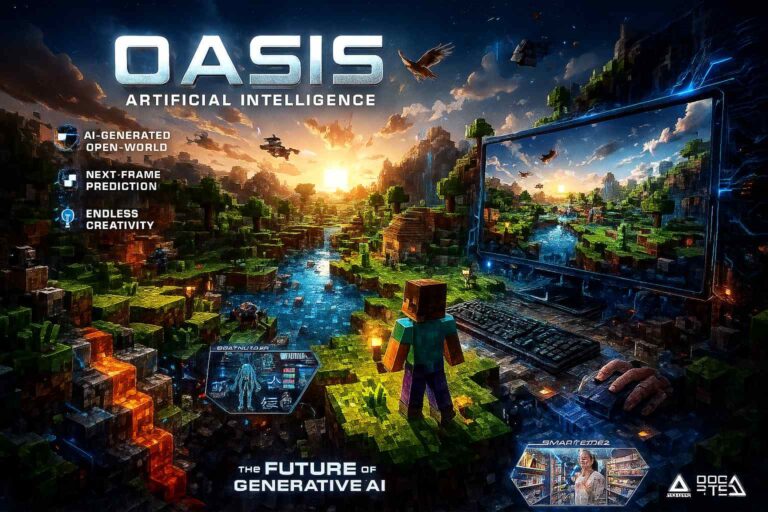
Oasis artifical intelligence is a proof-of-concept “open-world AI model” which creates everything that you view (physics, graphics, game rules) in real-time, from keyboard and mouse input. It is not a conventional game engine.
It was created by Decart (AI laboratory) and Etched (hardware company), beginning in 2022. It was unveiled as a public demonstration on October 31, 2024.
We will discuss the Oasis AI project, its technology, how it relates to wider uses of AI in various industries, and what it says about the future of artificial intelligence in this article.
What is Oasis Artificial Intelligence
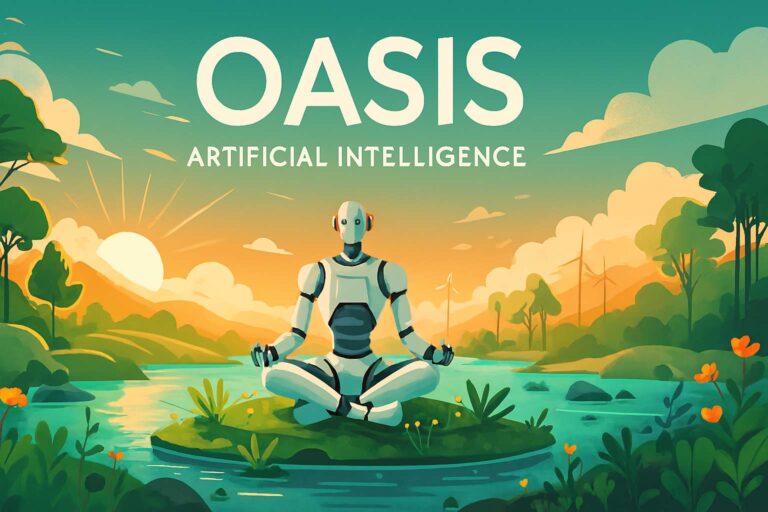
“Oasis Artificial Intelligence” is coined to describe both interconnected concepts.
Oasis started in 2022, when Robert Wachen (co-founder of Silicon Valley hardware startup Etched) and Dean Leitersdorf (co-founder of San Francisco-based AI startup Decart) began thinking about how generative AI could be used in interactive spaces. Both were intrigued by the prospect of training AI models not simply to produce text or images, but to model entire worlds.
The Broader Vision of Oasis AI: Unlike the demo, Oasis is a more advanced model that illustrates the impact of artificial intelligence beyond the gaming industry. Healthcare, finance, retail, smart cities and others can all benefit from the generative modeling and AI systems embedded in the foundational technology, showcasing the need to integrate AI into the systems to enhance operational efficacy.
The Oasis AI Project – AI-Powered Minecraft Clone
Background & Development (Decart + Etched)
The Oasis project started in 2022, when Dean Leitersdorf (co-founder at San Francisco AI company Decart) and Robert Wachen (co-founder at Silicon Valley hardware startup Etched) began discussing how generative AI could be used in interactive environments. Both were intrigued by the prospect of training AI models to not only produce text or images, but to mimic entire worlds.
With billionaire Oren Zeev and venture firm Sequoia Capital backing them, the team raised more than $21 million to turn their vision into reality. Their goal? To create a proof-of-concept open-world game model that could simulate Minecraft without using conventional game engines or hard-coded rules.
The title “Oasis” is inspired by the science fiction book and film Ready Player One, where OASIS is a huge, virtual simulated world. The analogy is appropriate—Oasis AI is the beginnings of AI-created virtual worlds.
On October 31, 2024, Decart made Oasis available to the public as a free demo. Within 24 hours, the website hosting the game came close to crashing due to the sheer amount of traffic. Gamers, developers, and AI fans flocked to get it, eager to see what AI could “play” the part of an entire game engine.
How Oasis Works (Next-Frame Prediction & Generative AI)
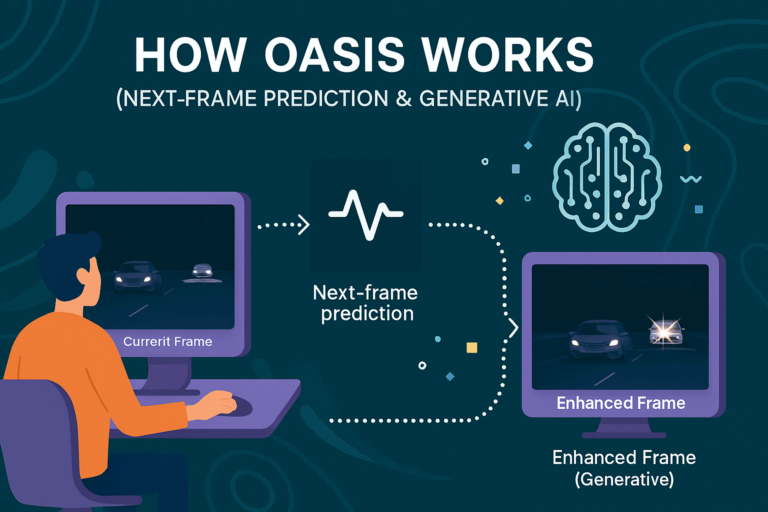
Oasis revolves around next-frame prediction, which is based on a powerful element termed ‘vision’. Rather than following a scripted sequence of logic or other ‘physical’ frameworks, it focuses on:
- The present video frame (the vision of the screen at the moment).
- The active input snapshot (keyboard and mouse activities).
- The continuum of past frames and sequences.
It iteratively and real-time predicts what the next frame ‘should’ be, one frame at a time.
Oasis’ approach is the same as what a large language model (like GPT) does: it predicts the ‘next’ word of a sentence. Unlike Oasis, language is not spatial—they are not constructed of words. Instead, Oasis predicts pixels and movements. The model learned how to ‘break’ the world while trained on millions of hours of Minecraft video scrapes: building blocks, constructing structures, battling mobs, and wandering the landscapes.
Reception & Limitations (Glitches, Unpredictability, Fun Factor)
Oasis, when it was released, received enormous attention, although the response was divided.
Positive responses:
- Most acclaimed it as a revolutionary breakthrough in AI research.
- People in the developing and research community perceived it as a glimpse into a future where AI might someday enable immersive, self-generating worlds.
- A few gamers enjoyed the unpredictability, labeling it as “playing Minecraft in a dream.”
Negative reactions:
- Critics noted the incoherence. The world rarely acts rationally.
- Performance was restricted, with low resolution and frame rates compared to actual Minecraft.
- The initial excitement wore off after a short time for some, as the demo had no goals, no structure, or no stability.
In spite of its shortcomings, Oasis was able to accomplish what it intended to: demonstrate that AI can create an interactive, open-world experience without programming. That is, it’s not a complete game—it’s a proof of concept.
Oasis Artificial Intelligence: Expanding the Concept
Although Oasis is a demo for a game, it also illustrates a much broader application of AI technology. The same technology used in Oasis – generative AI, predictive modeling, and real-time simulation – is now being used in other fields.
Why Oasis Matters for AI Research – AI Beyond Gaming
With Oasis, the importance is in the character of the AI, the departure from rule-based systems and learning-based systems. Most other games (and software for that matter) are designed with a set of rules created by a programmer Oasis unlike the others, is able to “learn the rules” from a large amount of data.
Applications of Oasis Artificial Intelligence
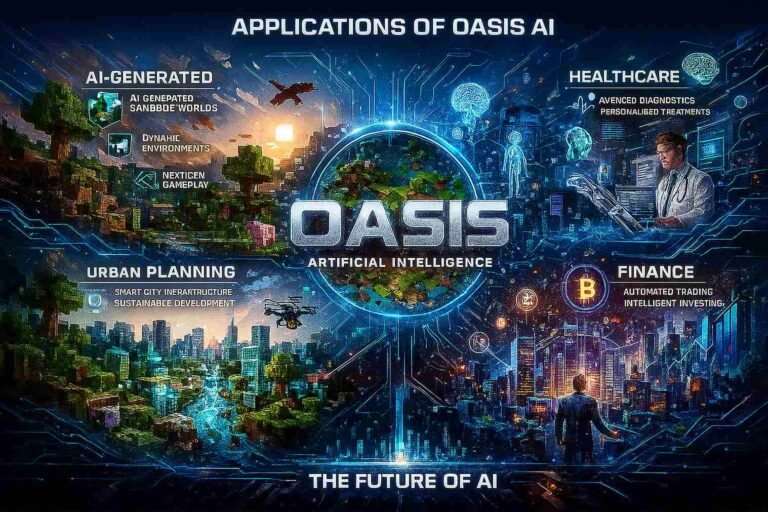
Even though Oasis began as an experiment in AI-generated gaming, the underlying technology has broader uses. If a machine can predict and generate real-time experiences in a virtual sandbox, it can also be applied in businesses where simulation, anticipation, and adaptability are crucial.
Healthcare
In medicine, predictive AI models can help with early diagnosis, treatment advice, and customized medicine. Just like how Oasis anticipates the subsequent frame from millions of Minecraft videos, a medical AI might anticipate the subsequent phase of a disease by viewing patient scans and medical history.
For instance:
AI might highlight earliest signs of cancer in X-rays before they are visible to human eyes.
Hospitals would be able to simulate patient outcomes using AI, trying out treatments virtually before implementing them in practice.
Similar to Oasis, these simulations require large volumes of data in order to be precise. The healthcare industry already produces massive datasets, so it is a prime place for Oasis-like predictive AI to take root.
Finance
The financial world thrives on prediction. Traders, banks, and insurers rely on forecasting risks and opportunities. Oasis AI’s next-frame prediction logic can be applied to finance by predicting next-market moves instead of game frames.
Applications include:
- Fraud detection: spotting unusual transaction “patterns” in real time.
- Risk modeling: simulating financial scenarios before they unfold.
- Algorithmic trading: making fast, data-driven trades that adapt to unpredictable markets.
Just like Oasis foretells what occurs when you press a button in Minecraft, AI in finance foretells what occurs when the market moves based on economic news, political developments, or unexpected demand alterations.
Retail & E-Commerce
Retail is being progressively personalized, and AI is at the forefront. Oasis illustrates the way AI can create worlds and adapt in a flash. In retail, this means:
- Personalized recommendations: recommending products based on browsing and buying history.
- Dynamic pricing models: real-time adjusting prices based on demand.
- Virtual shopping worlds: AI-created stores where every shopper’s experience is different.
Picture logging in to an online store where layout and recommendations respond in real time to your interests—much like Oasis responds to player input.
Smart Cities & Infrastructure
Cities are intricate systems with myriad moving parts: traffic, utilities, energy consumption, and population flow. Oasis demonstrates the ways in which AI can model interactive worlds. For smart cities, the same kinds of models might:
- Anticipate traffic patterns and maximize stoplights.
- Regulate energy grids by predicting demand.
- Model disaster recoveries, readying the city for floods, fires, or earthquakes.
If Oasis can model a blocky Minecraft world in real-time, AI could one day assist in modeling—and managing—cities’ living, breathing ecosystems.
Challenges of Oasis Artificial Intelligence
With every innovation comes challenge—and Oasis is no different.
Technical Barriers
- Low resolution and framerate relative to actual Minecraft.
- Weak memory persistence—AI occasionally “forgets” things it has done before.
- Random glitches or hallucinations.
Ethical Concerns
- Data privacy: Sensitive information could be harmful if abused.
- Bias: AI trained on biased data generates biased output.
- Ownership: Who owns AI-generated content?
Economic Impact
- Possible job replacement in gaming and creative industries.
- Creation of new opportunities—AI trainers, ethical overseers, simulation designers.
The Future of Oasis Artificial Intelligence
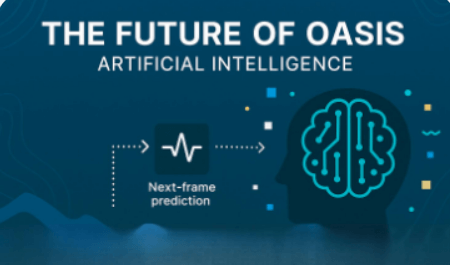
In Gaming
Look for AI-created infinite worlds—personalized, dynamic, and infinitely varied. Future iterations of Oasis-like technology may:
- Render in HD.
- Save memory to enable steady gameplay.
- Work with players as co-creators.
In Business and Society
- Firms running strategies in AI-created models.
- AI-assisted employee training simulations.
- Supply chain simulations to forecast bottlenecks ahead of time.
Forecasts for 2035
- AI-driven patient “digital twins” in medicine.
- AI-based smart cities streamlining traffic, energy, and security.
- AI-generated fully immersive educational worlds.
Conclusion: Oasis Artificial Intelligence
Oasis Artificial Intelligence is not simply a geeky AI experiment—it’s a peek into the future of AI-based worlds. By combining gaming and generative prediction, Oasis demonstrates how AI can mimic, learn, and generate interactive worlds.
Though today’s demo is unstable and buggy, its potential cannot be denied: it portends a future in which AI doesn’t just help, but makes. Whether in medicine, finance, retailing, or city planning, AI like Oasis could soon be the foundation of predictive, interactive systems globally.